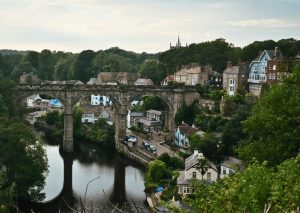
If you’ve ever wondered what England looked like before the Industrial Revolution, before motorways and supermarkets and chain coffee shops, Castle Combe is your answer. Tucked into the rolling hills of the southern Cotswolds, this place isn’t a “chocolate-box village” — it’s the chocolate-box village, the one they use as the template for all the others.
It’s been called the prettiest village in England so many times it’s almost a cliché. Before arriving, a part of me – call it the contrarian side – was gearing up to refute the claim. And yet, when I arrived and clapped eyes on the honey-coloured stone cottages with their steep gabled roofs and the Market Cross standing sentinel in the centre, I understood what the fuss was about.
This place feels and looks as though it has been suspended in time. I visited with my boyfriend and his lovely mum just after the summer holidays had drawn to a close, so we avoided the crowds and could enjoy the sights and sounds at a leisurely pace.
Getting to Castle Combe by car


Castle Combe is small — blink and you’ll miss it — but that’s part of the charm. Similar to entering a museum, there’s something about this place that demands a certain kind of silence. The main reason being that the residents at times have to put up with a substantial amount of visitors so everyone should keep their volume levels down to maintain the harmony.
There’s no sprawl, no neon, not even streetlights. Just a village surrounded by the beautiful Wiltshire countryside and winding roads. As we turned into the car park at the top of the village, we let out a collective gasp at the sight of a beautiful thatched-roof cottage. Now tell me you’re in the Cotswolds without telling me you’re in the Cotswolds.
Hopping out of the car, we paid for the parking (which is surprisingly affordable by the way) and made the short walk into the centre by foot.
By car: It’s about a 30-minute drive from Bath (around 12 miles) or just under an hour from Bristol.
By public transport: Take the train from Bath Spa to Chippenham (around 10 minutes). From Chippenham, catch a No.95/95A bus towards Castle Combe (around 25 minutes). The bus drops you near the village, and from there it’s a short walk in.
Why is the village named Castle Combe? Where’s the castle?


This is the question I found myself asking before I arrived. There’s no castle, so why is it called Castle Combe? Well, the name is literally a clue to its own past.
The “Castle” part comes from the castle that once stood on a hill just above the village after the Norman Conquest in the 11th century. The “Combe” part is Old English for “valley” – so the name essentially means “Castle in the Valley.”
As for the castle itself, unfortunately it’s long gone. By the 14th century, it had lost its military importance and was abandoned. Over time, it fell into ruin, and its stone was probably scavenged for other buildings in the village.
There seems to be very little recorded about the castle but if you want to read more, this archeology survey is the best I can find.
The village that time forgot

During the Middle Ages, Castle Combe prospered as a wool-producing village. The Cotswolds were famed for their sheep, and Castle Combe’s weavers produced some of the finest woollen cloth in England.
By the 15th century, the village was thriving, with its Market Cross erected at the centre of the village square to mark the right to hold a market. This was where merchants gathered to trade goods, where news was shared, and where the life of the village played out.
But like many rural villages, Castle Combe’s fortunes waned with the coming of the Industrial Revolution. Its small handlooms couldn’t compete with the mechanised mills springing up in northern England. As production shifted elsewhere, Castle Combe slipped into quiet obscurity – a decline that, ironically, preserved its charm. Without modernisation or industrial expansion, the village kept its medieval layout and its quaint stone cottages intact.
In the 20th century, Castle Combe was “rediscovered” – first by artists, then by filmmakers, and finally by tourists. Its picture-perfect setting has made it a popular filming location, appearing in movies like War Horse, Stardust, and Doctor Doolittle. Today, the village’s historic character is fiercely protected, with no new buildings allowed that would spoil the olde-worlde appeal.
Things to do and see in Castle Combe
The village doesn’t take long to explore. So if you’re not tempted by a long walk or hike, it’s a good idea to combine it with a trip to somewhere else nearby like Lacock Abbey or to see the extraordinary stones of Avebury. Here’s my guide to enjoying Castle Combe:
1. Walk the main street

This is the village you imagine when you think “Cotswolds.” The village is laid out like a film set – a single winding street lined with 14th-century cottages, sand-coloured stone that still shines on a grey day.
Admire all the cute details of an old-fashioned English village: little letter boxes, the quintessential red-pillar box telephone, and medieval tiber-framed buildings. And almost every cottage has its own whimsical name, with some providing a clue as to what the buildings were used for decades and even centuries ago.
2. Potter down West Street

West Street is a beautiful small lane with a row of charming houses. It’s important to be mindful of your noise levels because these homes (most of which I imagine are holidays rentals) sit directly onto the lane.
Just before you head through the gates there’s a lovely stone and timber-framed archway to your right. The lane provides access to the church and opens out onto some lovely countryside views overlooking Manor House Hotel.
3. Step inside St. Andrew’s Church

Built in the 13th century, St Andrew’s Church holds one of the oldest working clocks in England, dating back to the 1400s. No face, just a mechanism still quietly ticking away at the entrance. I don’t quite understand the mechanics of how it works but it still manages to strike the bell tower.


There’s also an immaculate medieval effigy of Walter Dunstanville that I found rather intriguing. He’s been carved into stone with his legs crossed to denote that he fought in two crusades. The Dunstanville destiny was a big deal back in the 12th Century, with history attributing the construction of the castle to Reginald de Dunstanville.
4. Admire the Italian garden at Manor House Hotel

After visiting the church we wandered over to Manor House Hotel to take a peek at the finest hotel in the village. The facade of the hotel draping with ivy is beyond beautiful and the building dates back from the 14 Century. If you’re looking to go somewhere for a special occasion or weekend retreat, I’m sure this place delivers.


Since we were not staying the night, we settled for a little wander around the adjoining Italian garden. It is brought to life by renaissance statues, delightful flower beds and perfectly clipped bushes. If you are interested in staying the night, it’s possible to check prices, availability, and book online.
5. Cross the bridge over Bybrook River

There are bridges, and then there’s this bridge. It’s the shot that makes every tourist brochure, every film location scout’s dream. Stardust, War Horse, and a dozen other productions have rolled cameras right here. The curve of the bridge, the cottages leaning in as if to say hello — it’s almost unnervingly perfect. Come early or late if you want it to yourself; during the day, expect camera-wielding pilgrims.
6. Lace up your hiking boots and head for the hills
Castle Combe is actually a brilliant place for a date with Mother Nature. You’ll plod along footpaths that wind through ancient woodland, rolling hills, and timeless farmland.
Follow one of the walking trails out of the village. Within minutes, you’ll be in open countryside dotted with sheep, the kind of pastoral view that has barely changed in centuries. The most popular route is the Castle Combe Circular Walk (6.2 miles / 10 kms) and here’s a list of more walking routes to choose from.
Where to eat in Castle Combe
Due to the size of the village, options are not massive. If you’re hungry, there’s the Castle Inn, where you can grab a pint and a plate of something hearty. For something light, there’s the Old Rectory Tearoom, where the cream tea is practically mandatory.
Looking for something fancy? Bybrook is a Michelin-starred restaurant that serves up modern British and European cuisine. It belongs to the Manor House Hotel but you don’t need to stay at the hotel to dine inside the restaurant. You will however need to reserve a table in advance of your visit.
Nearby places to visit
There are lots of amazing places to visit from Castle Combe within an hour or less of driving. Having a car makes it easier, but you can get to places using trains, buses or joining a guided tour that connects multiple places. To give you some ideas, I personally recommend the following places:
Bath (12 miles / 25 mins)
- Roman history and Georgian elegance rolled into one.
- Must-sees: The Roman Baths, Royal Crescent, The Circus, and the Thermae Spa. If you are basing yourself in the city, I’ve written a guide to the best day trips from Bath – there’s still a lot more to see!
- Perfect for foodies and architecture lovers alike.
Bristol (20 miles / 35 mins)
- A port city with grit and character.
- Highlights: Clifton Suspension Bridge, street art tours (Banksy’s hometown), harbourside museums, and craft beer bars.
- Feels urban and more edgy — a nice contrast to sleepy Castle Combe.
Avebury (22 miles / 35 mins)
- A prehistoric stone circle (largest in the world) that wraps around the whole village. No pictures can do this UNESCO World Heritage Site justice, but I’ve tried to encapsulate the magic in my guide to Avebury.
- You can actually walk right up to the stones — no fences, no tickets (as a result more enjoyable than Stonehenge in my opinion)
- Visit the Avebury Manor and nearby Silbury Hill, Europe’s largest man-made mound.
Wells (30 miles / 50 mins)
- My top pick! England’s smallest city, dominated by its Gothic cathedral. Read my travel guide to Wells for more information.
- Stroll Vicars’ Close, the oldest continuously inhabited street in Europe.
- Don’t miss the Bishop’s Palace with its moat fed by the springs that give Wells its name.









